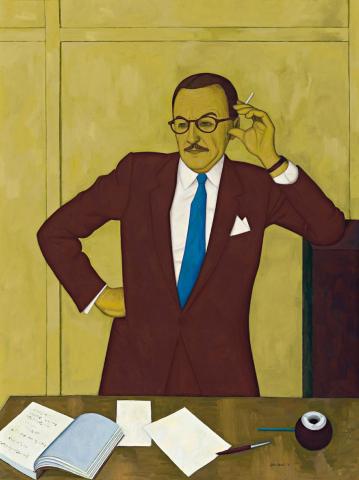PORTRAIT OF TAM PURVES, 1958
JOHN BRACK
oil on canvas
122.0 x 91.5 cm
signed and dated lower right: John Brack 58
Private collection, Melbourne
Second Anniversary Exhibition, Australian Galleries, Melbourne, 3–12 June 1958, cat. 9
Selling of Fine Office Furniture and Paintings by Important Australian Artists, Australian Galleries, Melbourne, 7–16 August 1958
Some Interesting Australians: A Loan Collection of Portraits, Georges Gallery, Melbourne, 8–26 August 1967
Portraits by John Brack, National Portrait Gallery, Canberra, 23 August – 18 November 2007
John Brack, National Gallery of Victoria, Melbourne, 24 April – 9 August 2009, Art Gallery of South Australia, Adelaide, 2 October 2009 – 26 January 2010 (label attached verso)
Shore, A., 'New markets for local painters',The Age, Melbourne, 3 June 1958, p. 2
Sayers, S., 'Office Art', The Age, Melbourne, 2 August 1958, p. 2 (illus.)
Millar, R., John Brack, Lansdowne Press, Melbourne, 1971, p. 107
Lindsay, R., McCaughey, P. and Hoff, U. ,John Brack: A Retrospective Exhibition, National Gallery of Victoria, Melbourne, 1987, p. 120
Grishin, S., The Art of John Brack, Oxford University Press, Melbourne, 1990, vol. I, p. 65, vol. II, cat. o75, pp. 12, 107 (illus.)
Sayers, A., Grishin, S. and Brack, H., Portraits by John Brack, National Portrait Gallery, Canberra, 2007, pp. 18, 60
Millar, R., 'Portraits by John Brack in Canberra', Art Monthly Australia, no. 206, December 2007 – January 2008, p. 32
Grant, K., John Brack, National Gallery of Victoria, Melbourne, 2009, p. 61 (illus.)
Study for Portrait of Tam Purves, 1958, conte, 73.0 x 51.0 cm, collection of the National Gallery of Victoria, Melbourne
Tam Purves, 1958, black chalk, 29.0 x 16.5 cm, collection of the National Gallery of Victoria, Melbourne
John Brack was a master portrait painter. His deeply moving Portrait of Harold Hattam 1965 (private collection), awarded the Gallaher Portrait Prize in the year it was painted, is unrivalled in Australian art for perceptive interpretation. In his exploration of the inner person through their outward appearance, Brack said:
'My portraits are not simply a sort of photograph appearance of the subject. I call them cerebral paintings. I am interested in obtaining a synthesis which is a commentary on the subject and human conditions. The portrait is not just the subject but what he means in the past, the present and the future.'1
Thomas Purves (1909-1969), better known as 'Tam', with his wife Anne founded the Australian Galleries in Smith Street, Collingwood, Melbourne, in 1956.Hawthorn-born Tam was the businessman, starting his career as a manufacturer's agent leading to eighteen years running a successful pattern business with his wife. At the Australian Galleries Tam provided the business acumen and Anne the artistic, promoting the careers of numerous top artists such as Sidney Nolan, John Perceval, Albert Tucker, Jeffrey Smart, and Brett Whiteley. Purves and his wife pioneered professional dealing in Australian contemporary art. Brack began exhibiting with them in 1957. The following year he painted three highly significant portraits" his artist friend Fred Williams, and his dealers Tam and Anne Purves. Anne's portrait followed that of her husband, a blend of beauty and shrewdness. Helen Brack described Tam's portrait exactly "'Here is an essay about a businessman, and John makes no concessions.'2 Standing in his office, the uncomfortable angularity of pose and biting colours, together with cleverly disposed details reveal in depth the personality and occupation of the sitter. Helen Brack has pointed to 'the barrier of the table top, with its strategically placed papers'.3 This effective presentation of the paraphernalia of business, the papers, pen and pencil deftly extends the definition of the sitter's profession and character. In addition to the interrelation of forms, objects and figure are linked in numerous ways - the blue tie and blue pencil, the unlit cigarette and ashtray, and the regulation white shirt and matching business papers. It was the age of short back and sides and conservatism in dress. Purves epitomises the businessman of his time through the strict conformity of his attire - dark suited, sharp - acumen combined with anxiety, indirect of look. The blue tie and hidden right hand not letting the left know what it is up to are some of the less ambiguous symbols. Colour throughout is used adroitly to extend analysis. The mustard face and background emphasise the astute and acerbic, repeated in the delineation of the sitter's face, eyebrows, moustache, and set of the dark-rimmed glasses.Brack's portrait of Purves dissects the character with brilliant scalpel sharpness.
1. Brack, quoted in Sayers, A., Grishin, S., and Brack, H., Portraits by John Brack, National Portrait Gallery, Canberra, 2007, p. 92. Brack, H., 'Some Notes on John's Portraits', in Sayers, et al, op. cit., p. 183. Ibid, p. 18
DAVID THOMAS
